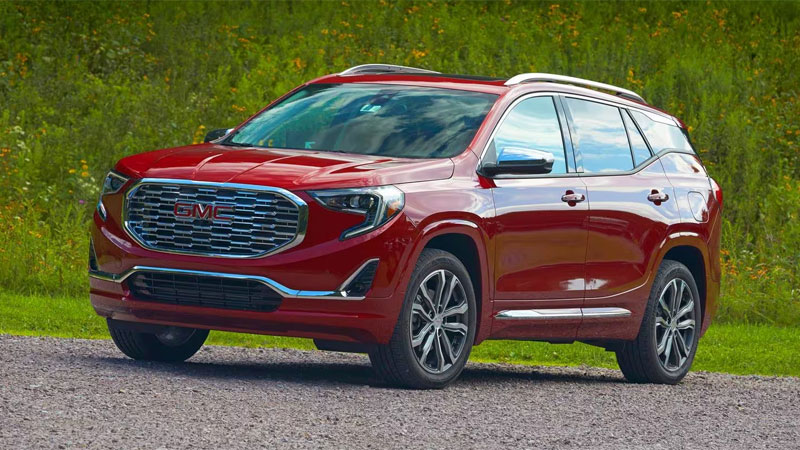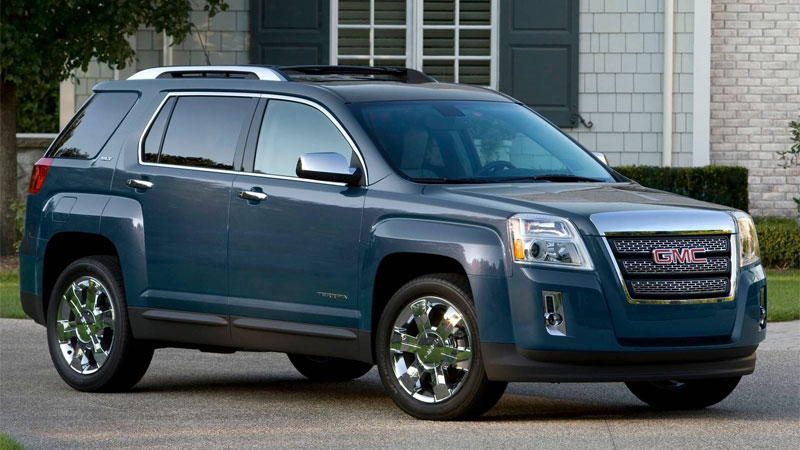GMC Terrain offers a more chiseled exterior than its Chevrolet cousin.
You might not know this, but the GMC Terrain has roots that trace back to a major American auto show. It made quite the entrance as a replacement for the Pontiac Torrent following the discontinuation of the Pontiac brand. With its debut in 2009, this compact SUV began its life cycle as a promising newcomer in its segment.
Among compact SUV nameplates, the 5-passenger GMC Terrain is one of the longest on the market, introduced for the 2010 model year. Available in front- and all-wheel-drive, this spacious crossover is related to the Chevrolet Equinox and shares its platform, powertrain choices and many other features.
Its look and feel is all GMC, with the brand’s trademark grill and trim levels. As you delve into its evolution over the years, you’ll find an SUV that has continuously adapted to meet the demands of drivers looking for both practicality and a touch of luxury.
See Also – Toyota Land Cruiser History
Concept and Development
Development for the GMC Terrain kicked off as a vital move by General Motors to introduce a compact SUV that would eventually replace the Pontiac Torrent. Unveiled in 2009, the Terrain was built on the Theta platform, shared by its sibling, the Chevrolet Equinox.
This bold crossover SUV was designed to blend the ruggedness of GMC’s heritage with the practicality needed for everyday use.
First Generation (2010-2017)
The Terrain hit the streets in 2010, a year that marked GMC’s ambitious foray into the compact crossover segment. You could see it as a replacement for the Pontiac brand, which had been recently retired.
Its reception hinged on offering a blend of size and efficiency that few competitors matched, resonating well with consumers who desired both qualities in an SUV.

2.4-liter Inline-four Engine
Standard engine for the GMC Terrain is an ECOTEC 2.4-liter (145 cubic inches) double overhead cam engine that is rated at 182-horsepower at 6,700 rpm and produces 172 foot-pounds of torque at 4,900 rpm.
This engine is paired with a 6-speed automatic transmission, enabling the FWD Terrain to achieve 22 mpg city, 32 mpg highway. When equipped with AWD, this Terrain is rated at 20 mpg city, 29 mpg highway.
This engine consumes regular gasoline or E85 fuel. Its 16-valve double overheard cam engine features spark ignition direct injection, variable valve technology and is of cast aluminum construction. The compression ratio for this engine is 11.2-to-1.
3.0-liter V-6 Engine
Optionally, a 24-valve double overhead cam 3.0-liter (183 cubic inches) engine is available and is paired with a 6-speed automatic transmission. The larger engine, rated at 264-horsepower at 6,950 rpm and producing 222 foot-pounds of torque at 5,100 rpm, is of sand-cast aluminum with cast-in bore liners and has cast aluminum cylinder heads.
Featuring direct sequential fuel injection with electronic throttle control, the V-6 engine achieves an EPA rating of 17 mpg city, 24 mpg highway with the FWD model. With the AWD Terrain, the EPA rates this model 16 mpg city, 23 mpg highway.
Like the base engine, the V-6 runs on regular gasoline or an ethanol blend. The compression ratio for this engine is 11.7-to-1.
Dimensions
If it is room that you seek, the GMC Terrain like its Chevrolet cousin, does not disappoint. This vehicle sits on a 112.5-inch wheelbase and is 185.3 inches long, 72.8 inches wide and 66.3 inches tall. Interior passenger volume is 99.6 cubic feet. Standard cargo space is 31.6 cubic feet behind the rear seat, expanded to 63.9 cubic feet with the rear seat folded down.
Weighing approximately two tons, this vehicle has a standard towing capacity of 1,500 pounds to a maximum of 3,500 pound when equipped with the V-6 engine and trailer towing package.
Highlights
Like all GMC products, trim levels are different from comparable Chevrolet products. For 2012, the GMC Terrain offers a new audio system, featuring an AM/FM/SiriusXM stereo with CD player and MP3 playback capability.
This vehicle offered a 7-inch touch-screen Color Interface Display, USB port, Radio Data System, speed compensated volume, auxiliary input jack and outside temperature display standard. Bluetooth connectivity; power windows, doors and mirrors; a tilt and telescopic steering wheel; a theft deterrent system; OnStar; a rear vision camera; daytime running lamps and fog lamps are among the many standard features offered across the Terrain model line.
Second Generation (2018-2021)
When you look at the GMC Terrain’s second generation, you’ll notice a drastic transformation beginning in 2018. This new generation showcases a move towards more sophisticated design choices and significant technological enhancements.
Complete Redesign

The 2018 Terrain marked a departure from the first generation with a complete redesign. This compact SUV introduced a sleek, floating-roof design and fog lamps that set a new standard for the model.
The dimensions have been meticulously crafted to provide a balance of comfort and functionality, while the new tail lights and daytime running lamps further accentuate its contemporary appearance.
Technological Advances
Your drive became more connected with the introduction of an advanced infotainment system that supports both Apple CarPlay and Android Auto.
With the availability of a Wi-Fi hotspot and OnStar services, the Terrain made sure you remained in touch and secure on the move. For sound enthusiasts, the various trims, including the luxurious Denali, offered a premium audio system.
Refresh and Updates
In 2021, the Terrain received a refresh that included restyled elements and new engine options. Under the hood, the turbocharged engines paired with an efficient 9-speed automatic transmission provided a refined driving experience.
This time frame also saw improvements in the SLE and SLT trims, with additional features to enhance your comfort and safety.
Special Editions and Trims
Over this period, you encountered special editions and new trims like the off-road-ready AT4. The Denali trim continued to epitomize luxury in a compact SUV, offering exclusive features like a head-up display and a more powerful, 3.6L V6 engine that was capable of churning out 264 horsepower.
The second generation also maintained choices between FWD and AWD, ensuring solid performance irrespective of the terrain, with a notable towing capacity to match your adventurous spirit.
2022 (2nd Gen Facelift)

Under the hood, the facelifted Terrain stuck with the reliable 1.5L Turbo Inline-4 Gas engine coupled with a smooth 9-speed automatic transmission. You had the choice of front-wheel drive for efficiency or all-wheel drive for those tough weather conditions.
Inside, the cabin’s tech got a boost. You were treated to the latest infotainment system, upping your connectivity game.
Following trim level changes, the basic SL model got dropped, making the SLE trim your new starting point. For the adventure seekers, the introduction of the new AT4 model added some off-road prowess to your driveway.
From a comfort and luxury standpoint, the Denali models came a bit later than the rest, but they didn’t skimp on the features that set them apart as the top-tier option.
Key changes for the 2022 Terrain didn’t just stop at aesthetics or trim options. It was also about enhancing your driving experience with more tech and comfort. Ready to dominate the road, the Terrain’s update surely kept it in the game for midsize SUVs.
Sales and Manufacturing
The initial production of the GMC Terrain kicked off on August 10, 2009, at the General Motors assembly plant in Ingersoll, Ontario. This facility became the birthplace of the Terrain, marking its place in the automotive world as a prominent crossover SUV.
Starting 2010, this compact SUV has had notable sales figures, indicating its steady popularity. General Motors has only disclosed quarterly sales numbers for recent years, focusing on its overall performance rather than monthly breakdowns.
Data from 2021 and 2022 shows that the Terrain continues to be a strong contender in the crowded segment of trucks and SUVs. It’s clear that the GMC Terrain has managed to create a significant impact, not just as a vehicle, but as a contributor to the automotive economy.
See Also – 2018 GMC Acadia Review
- 2024 Mazda CX-50: A Compact SUV with Premium Aspirations - Apr 15, 2024
- 2024 Ford Mustang (Iconic Pony Car Evolves) - Apr 4, 2024
- 2024 Ford Maverick (Looks Like a Truck, Drives Like a Car) - Mar 28, 2024

